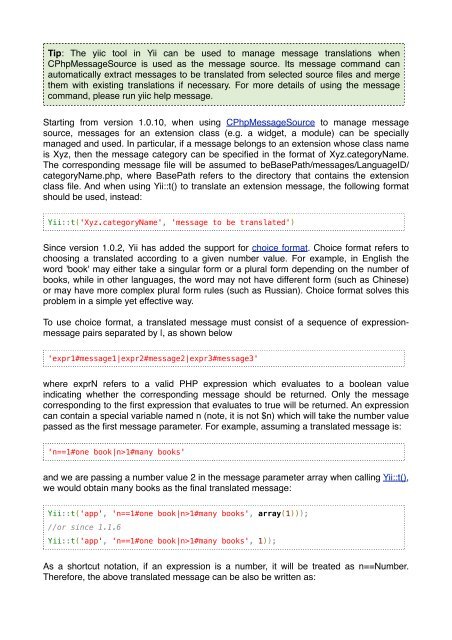O Guia Definitivo do Yii 1.1
O Guia Definitivo do Yii 1.1
O Guia Definitivo do Yii 1.1
You also want an ePaper? Increase the reach of your titles
YUMPU automatically turns print PDFs into web optimized ePapers that Google loves.
Tip: The yiic tool in <strong>Yii</strong> can be used to manage message translations when<br />
CPhpMessageSource is used as the message source. Its message command can<br />
automatically extract messages to be translated from selected source files and merge<br />
them with existing translations if necessary. For more details of using the message<br />
command, please run yiic help message.<br />
Starting from version 1.0.10, when using CPhpMessageSource to manage message<br />
source, messages for an extension class (e.g. a widget, a module) can be specially<br />
managed and used. In particular, if a message belongs to an extension whose class name<br />
is Xyz, then the message category can be specified in the format of Xyz.categoryName.<br />
The corresponding message file will be assumed to beBasePath/messages/LanguageID/<br />
categoryName.php, where BasePath refers to the directory that contains the extension<br />
class file. And when using <strong>Yii</strong>::t() to translate an extension message, the following format<br />
should be used, instead:<br />
<strong>Yii</strong>::t('Xyz.categoryName', 'message to be translated')<br />
Since version 1.0.2, <strong>Yii</strong> has added the support for choice format. Choice format refers to<br />
choosing a translated according to a given number value. For example, in English the<br />
word 'book' may either take a singular form or a plural form depending on the number of<br />
books, while in other languages, the word may not have different form (such as Chinese)<br />
or may have more complex plural form rules (such as Russian). Choice format solves this<br />
problem in a simple yet effective way.<br />
To use choice format, a translated message must consist of a sequence of expressionmessage<br />
pairs separated by |, as shown below<br />
'expr1#message1|expr2#message2|expr3#message3'<br />
where exprN refers to a valid PHP expression which evaluates to a boolean value<br />
indicating whether the corresponding message should be returned. Only the message<br />
corresponding to the first expression that evaluates to true will be returned. An expression<br />
can contain a special variable named n (note, it is not $n) which will take the number value<br />
passed as the first message parameter. For example, assuming a translated message is:<br />
'n==1#one book|n>1#many books'<br />
and we are passing a number value 2 in the message parameter array when calling <strong>Yii</strong>::t(),<br />
we would obtain many books as the final translated message:<br />
<strong>Yii</strong>::t('app', 'n==1#one book|n>1#many books', array(1)));<br />
//or since <strong>1.1</strong>.6<br />
<strong>Yii</strong>::t('app', 'n==1#one book|n>1#many books', 1));<br />
As a shortcut notation, if an expression is a number, it will be treated as n==Number.<br />
Therefore, the above translated message can be also be written as:










